Micromagnetic Study of the Dependence of Output Voltages and Magnetization Behaviors on Damping Constant, Frequency, and Wire Length for a Gigahertz Spin Rotation Sensor
Abstract
1. Introduction
2. Zero-Magnetostriction Amorphous Wire
2.1. Magnetic Domain Structure
2.2. Skin Effect
2.3. GSR Effect
3. Calculation Method
3.1. Landau–Lifshitz–Gilbert Equation
3.2. Magnetic Field via Eddy Currents
3.3. Magnetic Field Generated by Pulse Current and Output Voltage
4. Dependence of Output Voltage on Damping Constant
4.1. Calculation Model
4.1.1. Cylindrical Model
4.1.2. Pulse Current and External Magnetic Field
4.1.3. Magnetic Characteristics and Electric Resistivity
4.2. Verification of Eddy Current Calculations
4.3. Dependence of Output Voltage on Damping Constant
Output Voltage and Magnetization Behavior
5. Dependence of Output Voltage on Axial Length of Wire
5.1. Calculation Model
5.1.1. Cylindrical Model
5.1.2. Pulse Current and External Magnetic Field
5.1.3. Magnetic Characteristics and Electric Resistivity
5.2. Experimental Methods
5.3. Relationship between External Magnetic Field and Output Voltage for Each Axial Length
6. Conclusions
- A high output voltage can be obtained with a damping constant of ≥0.03.
- The output voltage increases up to a high-frequency current of 3 GHz.
- The shorter the axial length, the higher the external magnetic field when the output voltage reaches the peak value.
- The shorter the axial length, the stronger the demagnetization field at the end of the wire, making it difficult for the magnetization to return to the z-axis during the relaxation times of the first and second waves of the pulse current.
- The tendency of the dependence of the output voltage on the axial length agrees between the experimental and simulation results.
Author Contributions
Funding
Institutional Review Board Statement
Informed Consent Statement
Data Availability Statement
Conflicts of Interest
References
- Lenz, J.; Edelstein, A.S. Magnetic Sensors and Their Applications. IEEE Sens. J. 2006, 6, 631–649. [Google Scholar] [CrossRef]
- Mohri, K. Science and Technology on Magnetic Sensors, 4th ed.; Corona Publishing Co., Ltd.: Tokyo, Japan, 2016. [Google Scholar]
- Clarke, J.; Braginski, A.I. Applications of SQUIDs and SQUID Systems. In The SQUID Handbook; Wiley-VCH: Weinheim, Germany, 2006; pp. 269–390. [Google Scholar]
- Makhotkin, V.E.; Shurukhin, B.P.; Lopatin, V.A.; Marchukov, P.Y.; Livei, Y.K. Magnetic field sensors based on amorphous ribbons. Sens. Actuators A 1991, 27, 759–762. [Google Scholar] [CrossRef]
- Mohri, K.; Kawashima, K.; Kohzawa, T.; Yoshida, H. Magneto-Inductive Element. IEEE Trans. Magn. 1993, 29, 1245–1248. [Google Scholar] [CrossRef]
- Panina, L.V.; Mohri, K. Magneto-impedance effect in amorphous wires. Appl. Phys. Lett. 1994, 65, 1189–1191. [Google Scholar] [CrossRef]
- Mohri, K.; Humphrey, F.B.; Panina, L.V.; Honkura, Y.; Yamasaki, J.; Uchiyama, T.; Hiram, M. Advances of amorphous wire magnetics over 27 years. Phys. Status Solidi 2009, 206, 601–607. [Google Scholar] [CrossRef]
- Ohnaka, I.; Fukusako, T.; Ohmichi, T.; Masumoto, T.; Inoue, A.; Hagiwara, M. Production of Amorphous Flanet by In-rotating-liquid Spinning Method. Proceedings of 4th International Conference on Rapidly Quenched Metals, Sendai, Japan, 24–28 August 1981; pp. 31–34. [Google Scholar]
- Mohri, K.; Humphrey, F.B.; Yamasaki, J.; Okamura, K. Domain Wall Induced Anisotropy during Annealing in Amorphous Ribbons. IEEE Trans. Magn. 1984, 20, 1855–1857. [Google Scholar]
- Mohri, K.; Humphrey, F.B.; Yamasaki, J.; Kinoshita, F. Large Barkhausen Effect and Matteucci Effect in Amorphous Magnetostrictive Wires for Pulse Generator Elements. IEEE Trans. Magn. 1985, 21, 2017–2019. [Google Scholar] [CrossRef]
- Mohri, K.; Kohzawa, T.; Kawashima, K.; Yoshida, H.; Panina, L.V. Magneto-inductive Effect (MI effect) in Amorphous Wires. IEEE Trans. Magn. 1992, 28, 3150–3152. [Google Scholar] [CrossRef]
- Mohri, K.; Bushida, K.; Noda, M.; Yoshida, H.; Panina, L.V.; Uchiyama, T. Magneto-Impedance Element. IEEE Trans. Magn. 1995, 31, 2455–2460. [Google Scholar] [CrossRef]
- Mohri, K.; Uchiyama, T.; Panina, L.V. Recent Advances of Micro Magnetic Sensors and Sensing Application. Sens. Actuators 1997, 59, 1–8. [Google Scholar] [CrossRef]
- Menard, D.; Britel, M.; Ciureanu, P.; Yelon, A. Giant Magnetoimpedance in a cylindrical conductor. J. Appl. Phys. 1998, 84, 2805–2814. [Google Scholar] [CrossRef]
- Panina, L.V.; Markhnovskiy, D.P.; Mohri, K. Magnetoimpedance in amorphous wires and multifunctional applications: From sensors to tunable artificial microwave materials. J. Magn. Magn. Mater. 2004, 272–276, 1452–1459. [Google Scholar] [CrossRef]
- Zhukov, A.; Zhukova, V.; Blanco, J.M.; Gonzalez, J. Recent research on magnetic properties of glass-coated microwires. J. Magn. Magn. Mater. 2005, 294, 182–192. [Google Scholar] [CrossRef]
- Mohri, K. A Micro Magnetic Sensor Based on MI Effect. Japan Patent No. JP3645116, 10 March 1999. [Google Scholar]
- Honkura, Y. Development of amorphous wire type MI sensor for automobile use. J. Magn. Magn. Mater. 2002, 249, 375–381. [Google Scholar] [CrossRef]
- Panina, L.V.; Mohri, K.; Uchiyama, T. Giant magneto-impedance (GMI) in amorphous wire, single layer film and sandwich film. Phys. A 1997, 241, 429–438. [Google Scholar] [CrossRef]
- Antonov, A.S.; Iakubov, I.T.; Lagarkov, A.N. Nondaiagonal impedance of amorphous wires with circular magnetic anisotropy. J. Magn. Magn. Maer. 1998, 187, 252–260. [Google Scholar] [CrossRef]
- Zhukov, A.; Talaat, A.; Ipatov, M.; Zhukova, V. High frequency giant magnetoimpedance effect of amorphous microwires for magnetic sensors applicat ions. Int. J. Smart Sens. Intell. Syst. 2014, 7, 1–6. [Google Scholar]
- García-Chocano, V.M.; García-Miquel, H. DC and AC linear magnetic field sensor based on glass coated amorphous microwires with Giant Magnetoimpedance. J. Magn. Magn. Mater. 2015, 378, 485–492. [Google Scholar] [CrossRef]
- Agra, K.; Mori, T.J.A.; Dorneles, L.S.; Escobar, V.M.; Silva, U.C.; Chesman, C.; Bohn, F.; Corrêa, M.A. Dynamic magnetic behavior in non-magnetostrictive multilayered films grown on glass and flexible substrates. J. Magn. Magn. Mater. 2014, 355, 136–141. [Google Scholar] [CrossRef]
- Shcherbinin, S.V.; Pérez, R.; Vazquez, M.; Kurlyandskaya, G.V. Ferromagnetic resonance in electroplated CuBe/FeCoNi and amorphous CoFeSiB wires Ferromagnetic resonance in electroplated CuBe/FeCoNi and amorphous CoFeSiB wires. IEEE Trans. Magn. 2020, 56, 2800110. [Google Scholar] [CrossRef]
- Honkura, Y.; Honkura, S. The Development of ASIC Type GSR Sensor Driven by GHz Pulse Current. In Proceedings of The Ninth International Conference on Sensor Device Technologies and Applications, SENSORDEVICES 2018, Venice, Italy, 16–20 September 2018; pp. 15–22, ISBN 978-1-61208-660-6. [Google Scholar]
- Honkura, Y.; Honkura, S. The development of a micro-coil-on-ASIC type GSR sensor driven by GHz pulse current. J. Magn. Magne. Mater. 2020, 513, 167240. [Google Scholar] [CrossRef]
- Honkura, Y. Chaptrer 3: Electronics Compass and Motion Sensor Using MI Sensor. In New Magnetic Sensors and Their Applications; Triceps Co., Ltd.: Tokyo, Japan, 2013. [Google Scholar]
- Vereshchagin, M.; Baraban, I.; Leble, S.; Rodionova, V. Structure of head-to-head domain wall in cylindrical amorphous ferromagnetic microwire and a method of anisotropy coefficient estimation. J. Magn. Magn. Mater. 2020, 504, 166646. [Google Scholar] [CrossRef]
- Vereshchagin, M. Structure of domain wall in cylindrical amorphous microwire. Phys. B Condens. 2018, 549, 91–93. [Google Scholar] [CrossRef]
- Betancourt, I.; Hrkac, G.; Schrefl, T. Micromagnetic study of magnetic domain structure and magnetic reversal in amorphous wires with circular anisotropy. J. Magn. Magn. Mater. 2011, 323, 1134–1139. [Google Scholar] [CrossRef]
- Janutka, A.; Gawronski, P. Structure of magnetic domain wall in cylindrical microwire. IEEE Trans. Magn. 2015, 51, 1500106. [Google Scholar] [CrossRef]
- Jin, F.; Li, J.; Zhou, L.; Peng, J.; Chen, H. Simulation of Giant Magnetic-Impedance Effect in Co-Based Amorphous Films With Demagnetizing Field. IEEE Trans. Magn. 2015, 51, 7100404. [Google Scholar] [CrossRef]
- Honkura, Y. Chapter 5 Section 4: Development of High Sensitive Micro Magnetic Sensor based on GSR Effect. In New Magnetic Sensors and Their Applications; Technical Information Institute Co. Ltd.: Tokyo, Japan, 2018. [Google Scholar]
- Honkura, Y.; Honkura, S. The Development of a High Sensitive Micro Size Magnetic Sensor Named as GSR Sensor Excited by GHz Pulse Current. In Proceedings of the 2018 Progress in Electromagnetics Research Symposium (PIERS-Toyama), Toyama, Japan, 1–4 August 2018; IEEE: New York, NY, USA, 2018; pp. 324–331. [Google Scholar]
- Honkura, Y. Update on development of extremely high sensitive micro magnetic sensor “GSR sensor”. Text Book 4th Study Group Meet. MSJ Extrem. High Sensitive Micro Magn. Sens. 2016, 4, 10–16. [Google Scholar]
- Uehara, Y.; Furuya, A.; Shimizu, K.; Fujisaki, J.; Ataka, T.; Tanaka, T.; Oshima, H.; Nakayama, K.S.; Yabukami, S. Micromagnetic analysis of dynamic magnetization process in an amorphous wire for MI sensor. IEICE Tech. Rep. 2015, 115, 1–5. [Google Scholar] [CrossRef]
- Kaneko, T.; Honkura, Y.; Honkura, S.; Akagi, F. Effects of fall times of pulse currents on output voltages in amorphous-wire-based magnetic sensors. IEEE Trans. Magn. 2022, 58, 4002405. [Google Scholar] [CrossRef]
- Akagi, F.; Ohta, H. Ultra-high Sensitivity Magnetic Impedance sensor by Applying GHz Pulse Current. In Proceedings of the 2019 Annual Conference on Magnetism and Magnetic Materials, Las Vegas, NV, USA, 4–8 November 2019. Dig. GV-03. [Google Scholar]
- Frommberger, M.; McCord, J.; Quand, E. High-Frequency Properties of FeCoSiB Thin Films with Crossed Anisotropy. IEEE Trans. Magn. 2004, 40, 2703–2705. [Google Scholar] [CrossRef]
- Vazquez, M.; Hernando, A. A soft magnetic wire for sensor applications. J. Phys. D Appl. Phys. 1996, 29, 939–949. [Google Scholar] [CrossRef]
- Antonov, A.S.; Borisov, V.T.; Borisov, O.V.; Pozdnyakov, V.A.; Prokoshin, A.F.; Usov, N.A. Residual quenching stresses in amorphous ferromagnetic wires produced by an in-rotating-water spinning process. J. Phys. D Appl. Phys. 1999, 32, 1788–1794. [Google Scholar] [CrossRef]
- Sunagawa, S. Riron Denjikigaku (Theoretical Electromagnetism), 3rd ed.; Kinokuniya Bookstore: Tokyo, Japan, 2016; pp. 181–183. [Google Scholar]
- Brown, W.F.; LaBonte, A.E. Structure and Energy of One-Dimensional Domain Walls in Ferromagnetic 2 Thin Films. J. Appl. Phys. 1965, 36, 1380–1386. [Google Scholar] [CrossRef]
- Hayashi, N.; Nakatani, Y.; Inoue, T. Numerical Solution of Landau-Lifshitz-Gilbert Equation with Two Space Variables for Vertical Bloch Lines. Jpn. J. Appl. Phys. 1988, 27, 366–378. [Google Scholar] [CrossRef]
- Victora, R.H. Micromagnetic predictions for barium ferrite particles. J. Appl. Phys. 1989, 63, 3423–3428. [Google Scholar] [CrossRef]
- Nakatani, Y.; Uesaka, Y.; Hayashi, N. Direct Solution of the Landau-Lifshitz-Gilbert Equation for Micromagnetics. Jpn. J. Appl. Phys. 1989, 28, 2485–2507. [Google Scholar] [CrossRef]
- Akagi, F. Magnetic Domain Structures and Techniques in Micromagnetics Simulation. Magnetism and Its Modeling. In Magnetic Material for Motor Drive Systems Fusion Technology of Electromagnetic Fields, 1st ed.; Fujisaki, K., Ed.; Springer: Gateway East, Singapore, 2019; pp. 165–179. [Google Scholar]
- Uda, E.; Yokoe, M.; Yoshida, K.; Kanai, Y. Oscillation Characteristics and Influences of Eddy Current on Oscillator for MAMR. J. Magn. Soc. Jpn. 2009, 33, 357–361. [Google Scholar] [CrossRef]
- Torre, E.D.; Eicke, J.G. Eddy Currents in Micromagnetics calculations. IEEE Trans. Magn. 1997, 33, 1251–1254. [Google Scholar] [CrossRef]

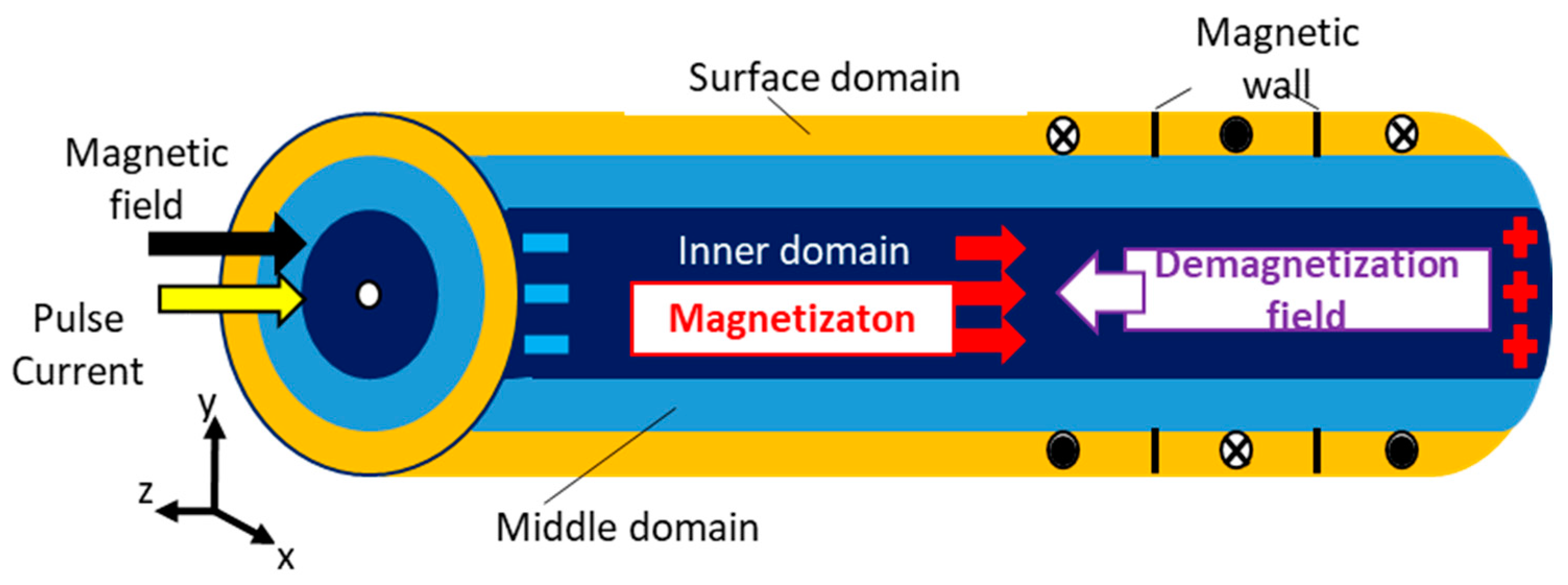
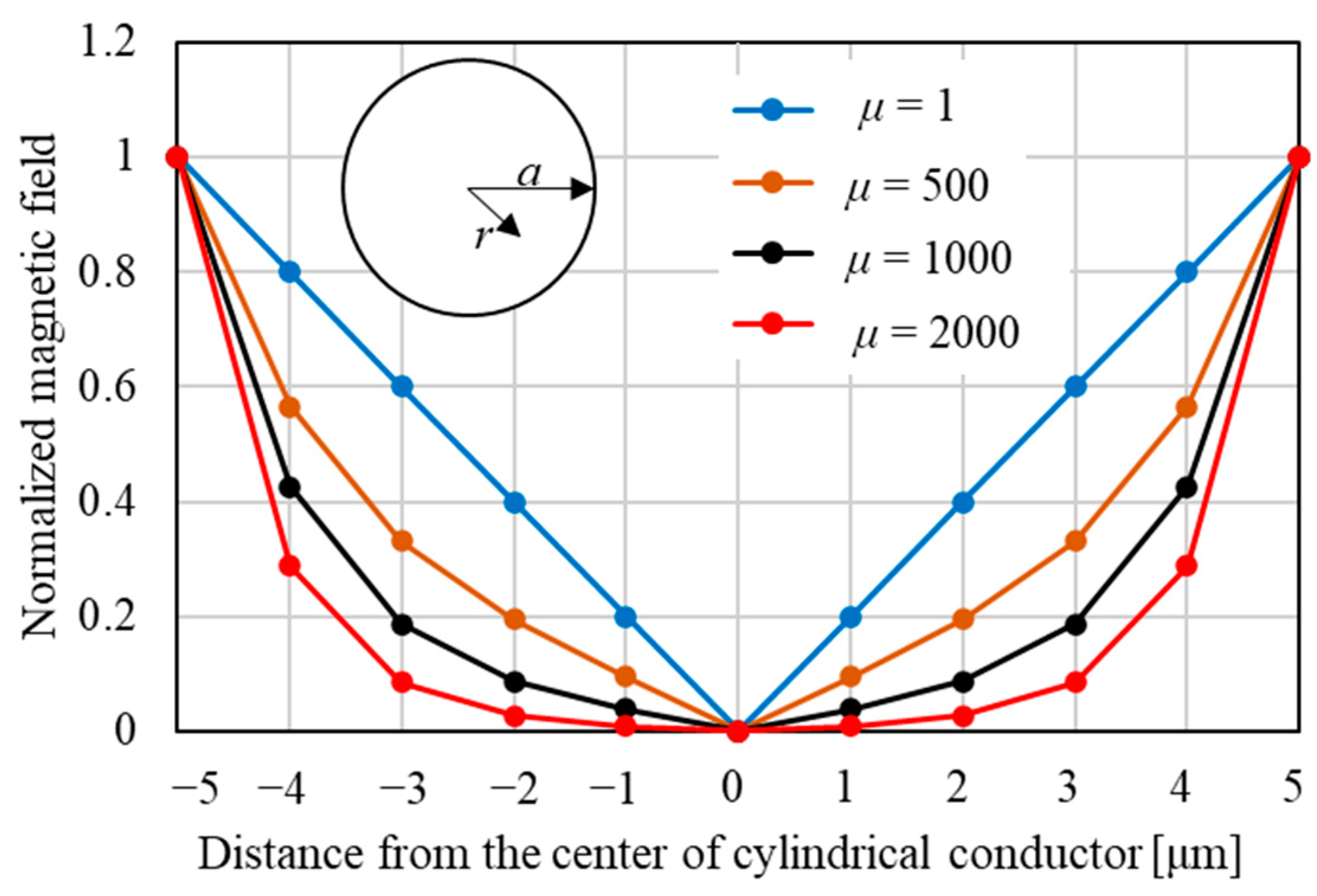
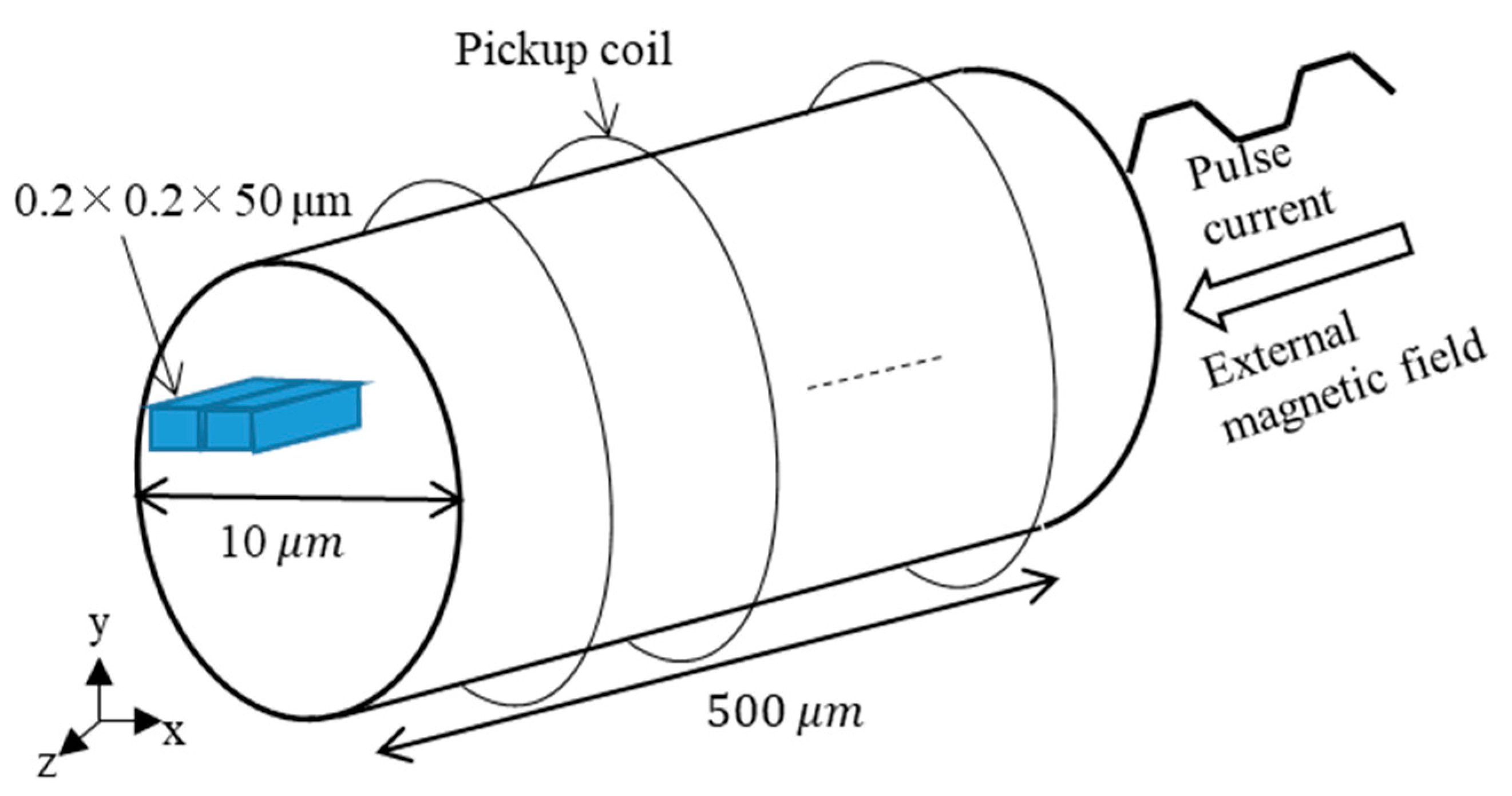
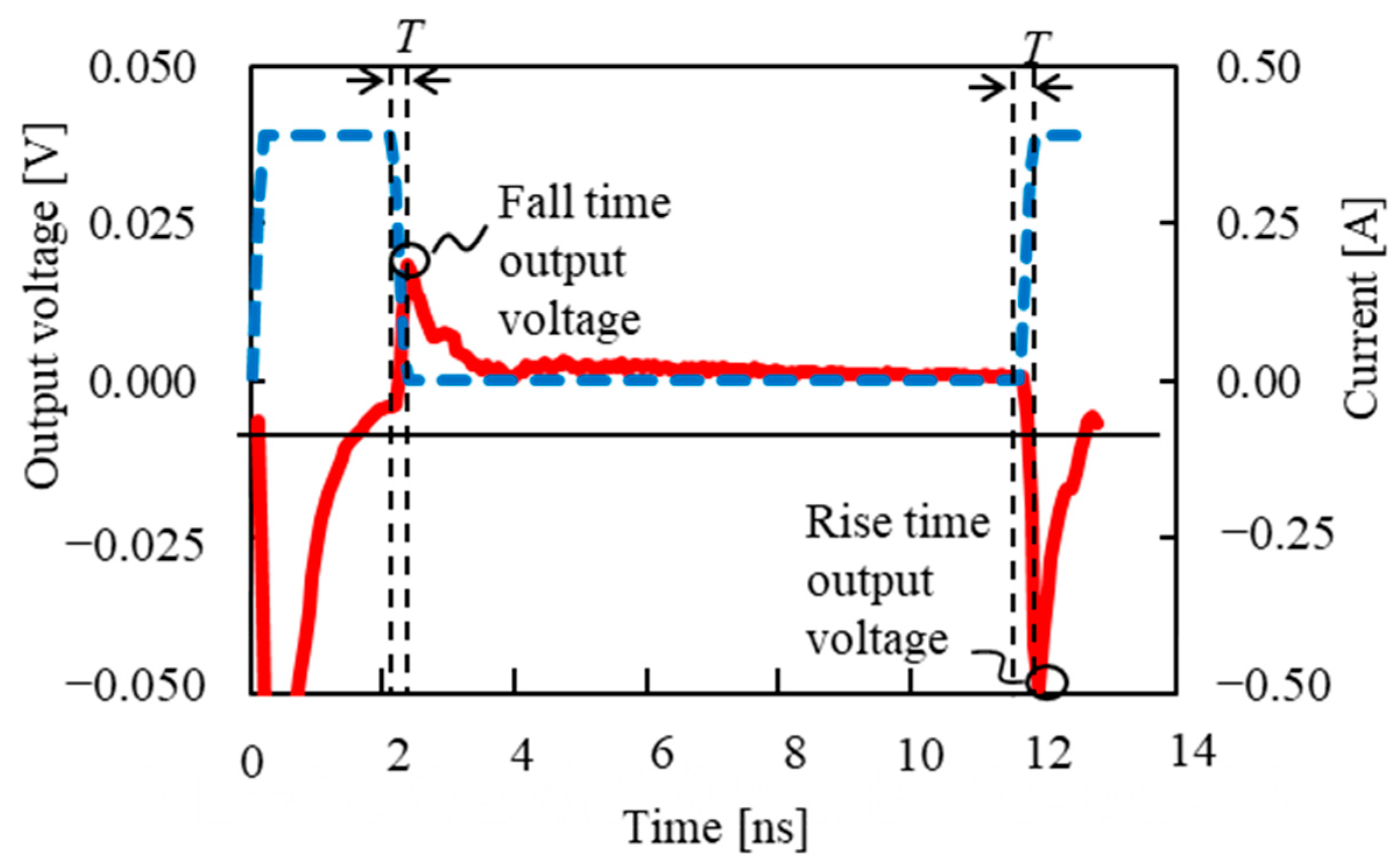
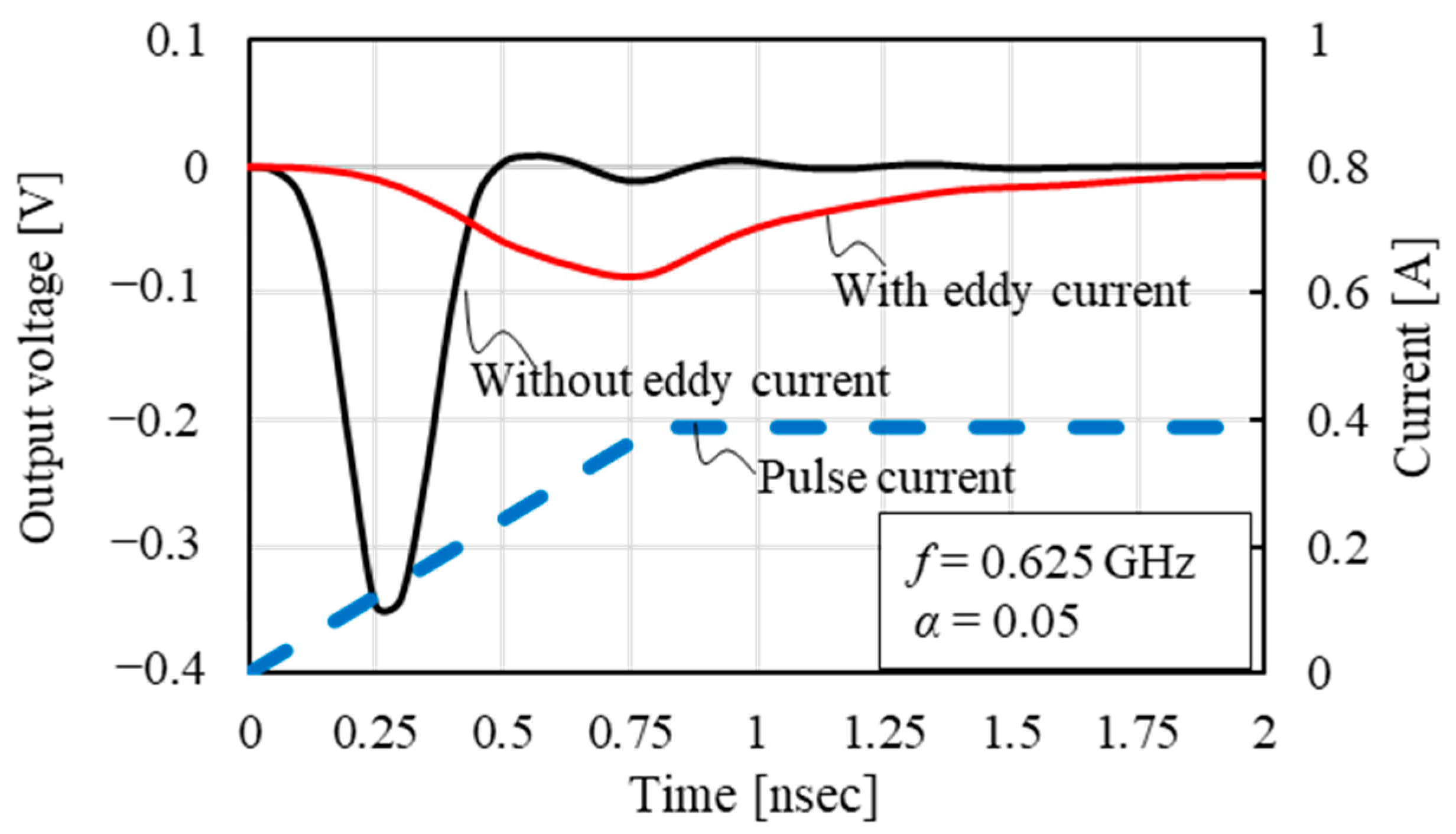
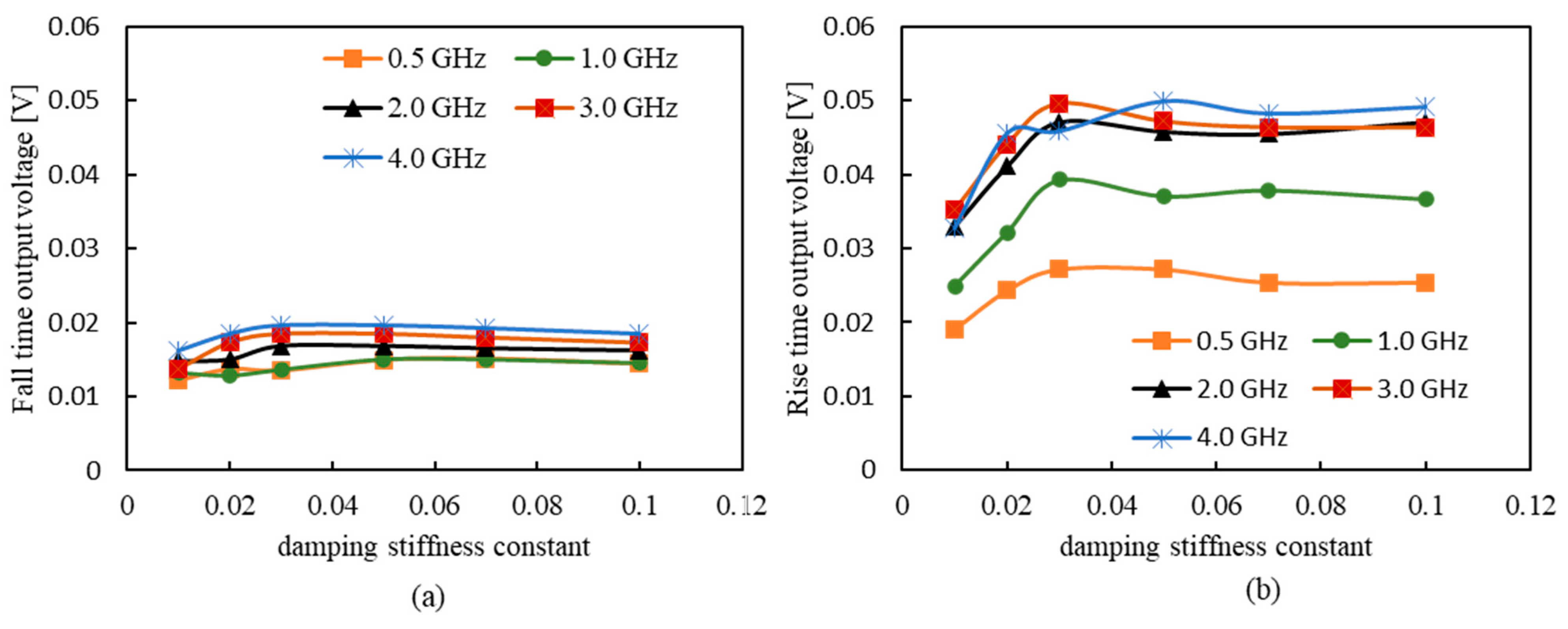
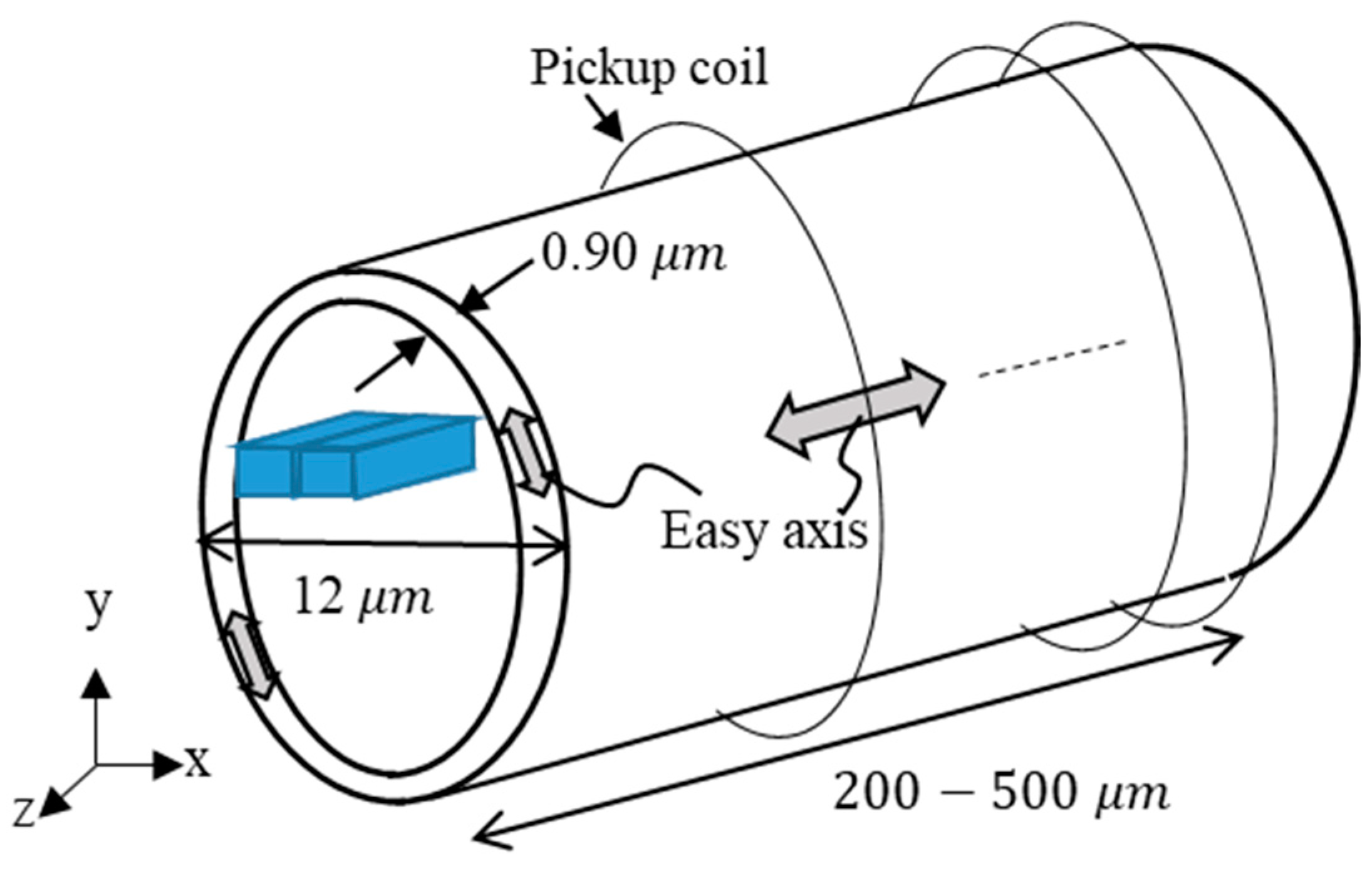
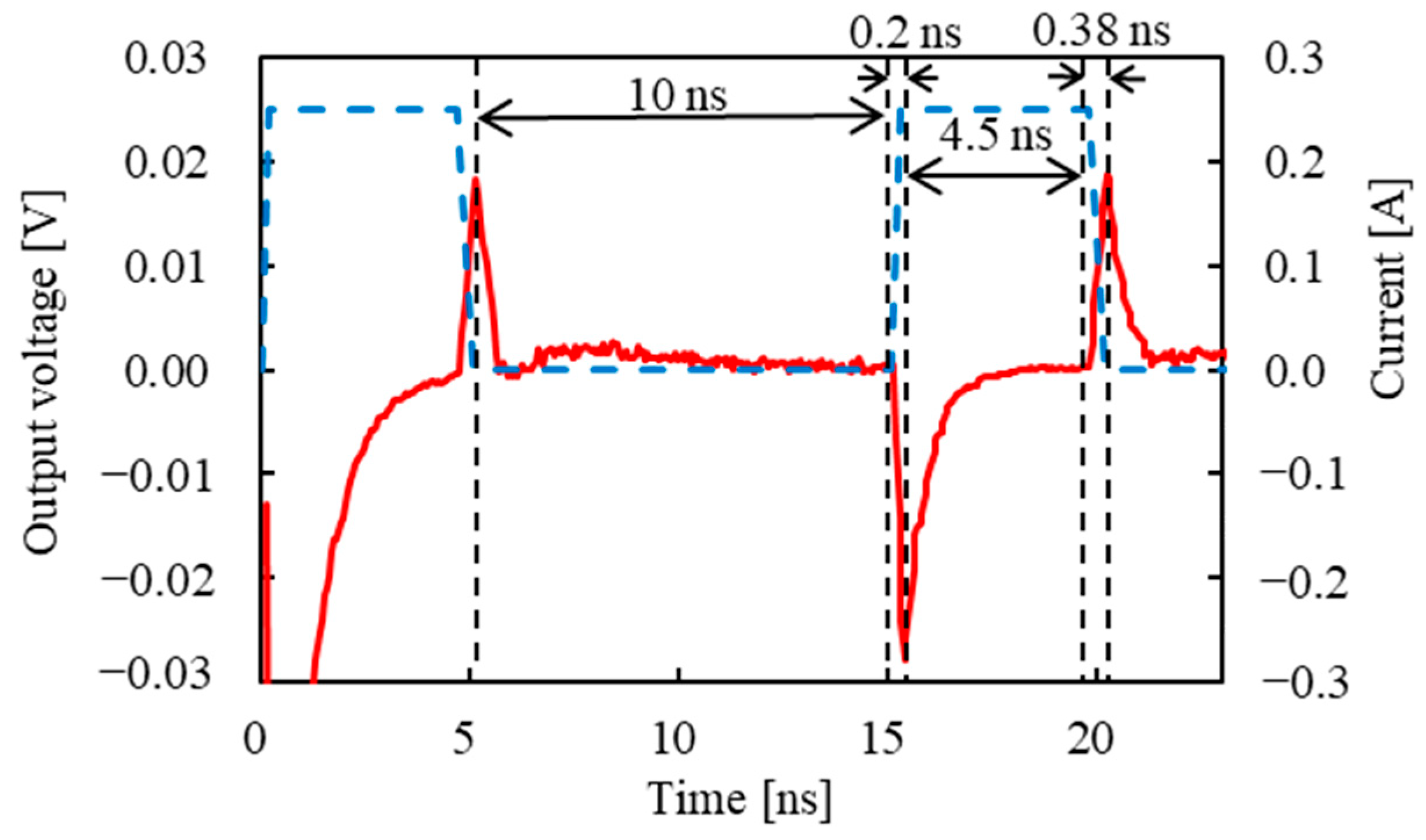
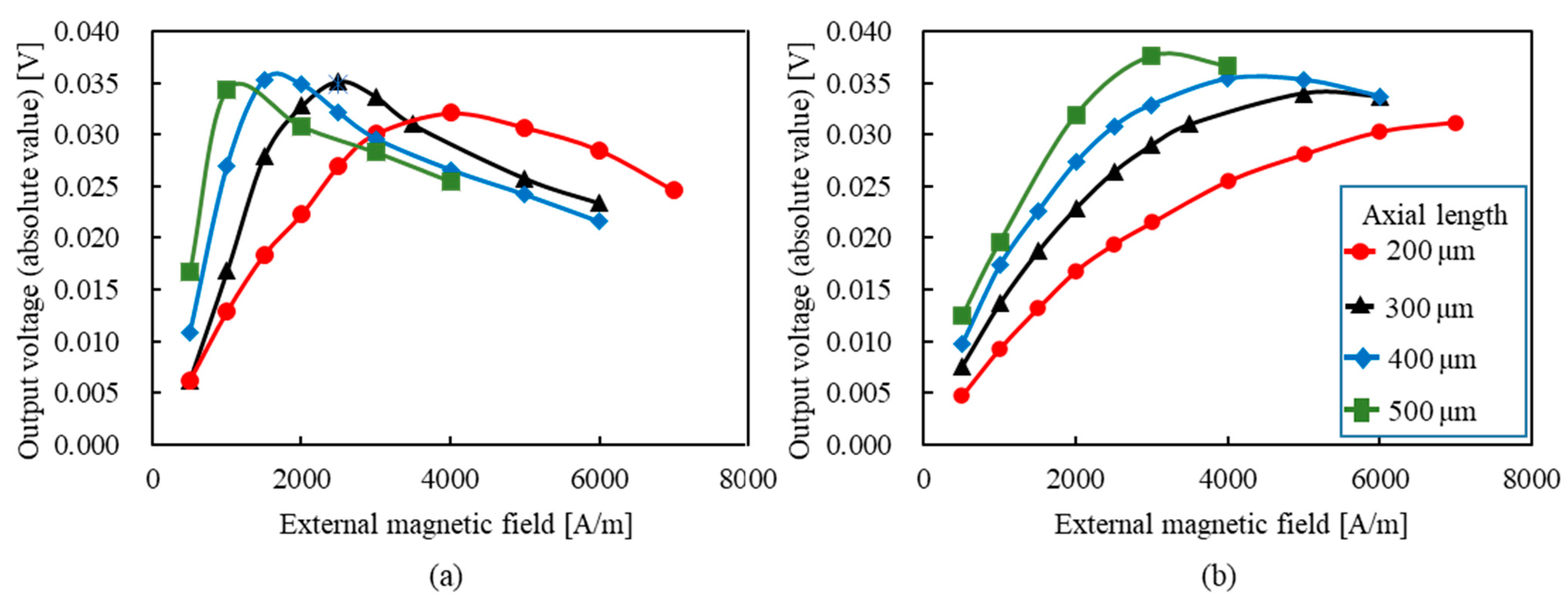

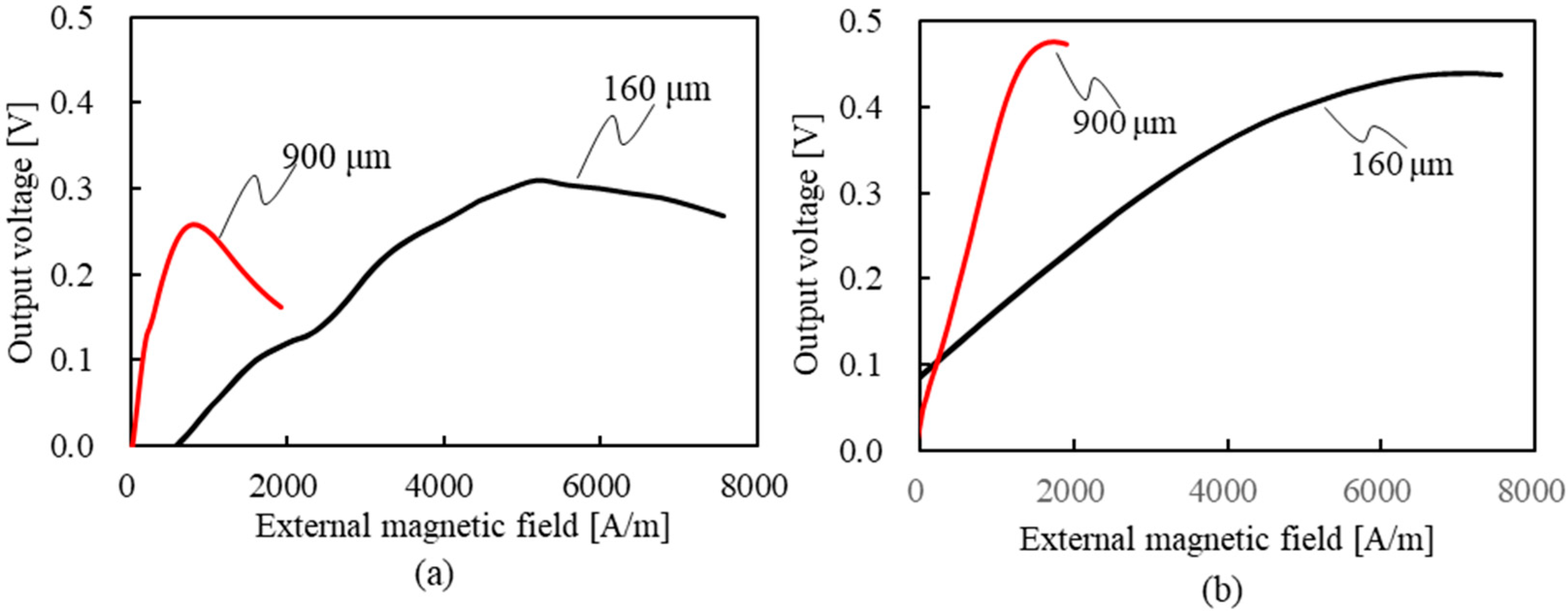
| Parameter | Value |
|---|---|
| Anisotropy constant [J/m3] | 250 |
| Saturation magnetization [T] | 1.0 |
| Exchange stiffness constant [J/m] | 1.0 × 10−11 |
| Electric resistivity µΩ m | 1.3 |
Disclaimer/Publisher’s Note: The statements, opinions and data contained in all publications are solely those of the individual author(s) and contributor(s) and not of MDPI and/or the editor(s). MDPI and/or the editor(s) disclaim responsibility for any injury to people or property resulting from any ideas, methods, instructions or products referred to in the content. |
© 2023 by the authors. Licensee MDPI, Basel, Switzerland. This article is an open access article distributed under the terms and conditions of the Creative Commons Attribution (CC BY) license (https://creativecommons.org/licenses/by/4.0/).
Share and Cite
Akagi, F.; Kaneko, T.; Kan, H.; Honkura, Y.; Honkura, S. Micromagnetic Study of the Dependence of Output Voltages and Magnetization Behaviors on Damping Constant, Frequency, and Wire Length for a Gigahertz Spin Rotation Sensor. Sensors 2023, 23, 2786. https://doi.org/10.3390/s23052786
Akagi F, Kaneko T, Kan H, Honkura Y, Honkura S. Micromagnetic Study of the Dependence of Output Voltages and Magnetization Behaviors on Damping Constant, Frequency, and Wire Length for a Gigahertz Spin Rotation Sensor. Sensors. 2023; 23(5):2786. https://doi.org/10.3390/s23052786
Chicago/Turabian StyleAkagi, Fumiko, Terumi Kaneko, Hirotada Kan, Yoshinobu Honkura, and Shinpei Honkura. 2023. "Micromagnetic Study of the Dependence of Output Voltages and Magnetization Behaviors on Damping Constant, Frequency, and Wire Length for a Gigahertz Spin Rotation Sensor" Sensors 23, no. 5: 2786. https://doi.org/10.3390/s23052786
APA StyleAkagi, F., Kaneko, T., Kan, H., Honkura, Y., & Honkura, S. (2023). Micromagnetic Study of the Dependence of Output Voltages and Magnetization Behaviors on Damping Constant, Frequency, and Wire Length for a Gigahertz Spin Rotation Sensor. Sensors, 23(5), 2786. https://doi.org/10.3390/s23052786




